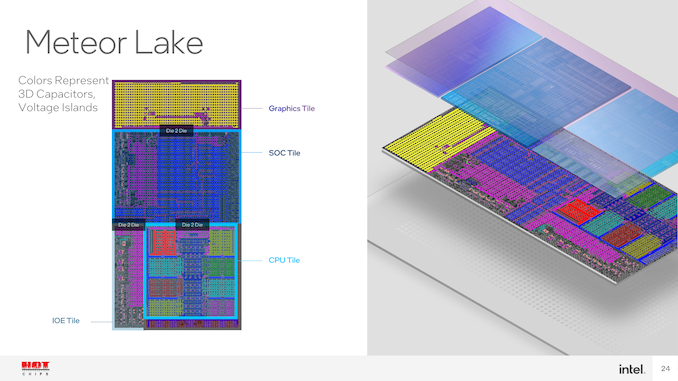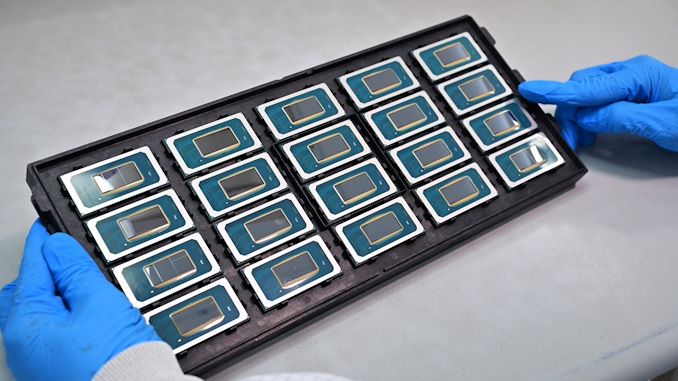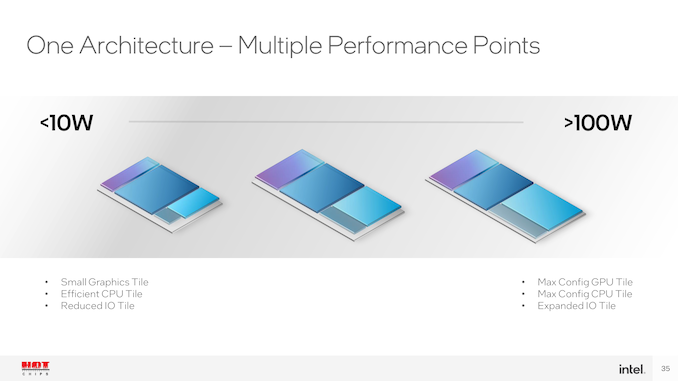Intel Unveils Meteor Lake Architecture: Intel 4 Heralds the Disaggregated Future of Mobile CPUs
by Gavin Bonshor on September 19, 2023 11:35 AM ESTIntel Meteor Lake: Changing The Strategy, Laying the Foundation for Intel 3
The strategy for both the Intel 4 process and the first architecture built on it, Meteor Lake, looks to change the dynamic for the mobile market and the foreseeable future of Intel's client processors. With the Foveros 3D packaging, opting for a power-conscious mobile platform seemed the best way to showcase their gains in terms of power efficiency.
One of the main product assembly advantages of Foveros packaging is that Intel can chop and change tiles depending on the processor, which includes current technologies, I/O, graphics, and compute cores. This approach to 3D tiled packaging also means that it is theoretically easier to introduce new tiles with faster cores with higher IPC performance, new graphics processors, and newer I/O, such as Wi-Fi 7. With Foveros not limiting Intel to use a single, monolithic die, it allows Intel to use different manufacturing processes for each of the tiles and integrate them onto the silicon. This is prevalent with the compute tile being built on Intel 4, while the graphics tile in Meteor Lake is made using TSMC's N5 node. This flexibility is key to advancing innovation, customizability, and, of course, wafer yield.

Intel Meteor Lake from Hot Chips Slide Deck
Intel also introduced a dedicated in-silicon AI engine through the NPU within the SoC tile. Similar to AMD with their Ryzen AI technology, Intel is looking to capitalize on the AI rush within its client-focused processors, but with support for OpenVINO and also including MCDM driver-compliance, users can do some pretty cool things with AI inferencing on the chip. Although these implementations aren't akin to the types of AI inferencing done in the cloud via ChatGPT with dedicated AI hardware, it's a step in the right direction in a world that looks to be slowly taken over by AI.
Wrapping things up, while Intel is confirming that Meteor Lake is coming to mobile-first, any details beyond that are slim pickings. At this point in time, Intel hasn't revealed anything in regard to SKUs or possible configurations. Everything disclosed is based on the 'full; Meteor Lake processors, but Intel hasn't spoken about different configurations or what the lower-end segment might look like regarding tiles and implementations. From their Hot Chips disclosures, offering a tiled architecture allows them to scale upwards and down depending on the SKU. The high-end SKU, which hasn't been disclosed yet, will feature the full configuration and implementation of all the features. Otherwise, the scalable nature of Meteor Lake and disaggregation allows for different levels of compute and graphics tiles and the ability to scale the input and output (I/O) depending on the device.
Meteor Lake will also be the first mobile platform from Intel to use their new Core naming scheme for products, which drops the 'i' from the Core branding. This includes the Core 3, 5, and 7, as well as higher spec Ultra 5, 7, and 9 Ultra tiers. Pat Gelsinger, Intel's Chief Executive Officer (CEO), during his opening keynote at Intel Innovation 2023, states that Intel is launching the first Meteor Lake Ultra (high-end) SKU with AI capabilities (NPU) on December 14th.

A tray of Meteor Lake Core Ultra processors (Credit, Intel)
We expect Intel to disclose more about specific SKUs and other specifications, such as clock speeds and core configurations, as we get closer to Meteor Lake's launch. Although we're expecting Ultra-focused Meteor Lake SKUs to launch on December 14th, no details on when we can expect other SKUs are set to hit retail channels. Meteor Lake is likely to launch with the top Ultra SKU or at least one that is close to the top of the stack.
Reading the tea leaves ahead of Innovation 2023, one gets the impression that Intel was hoping to be just a bit closer to launch by now than they actually are. But all things will eventually come in due time...











107 Comments
View All Comments
FWhitTrampoline - Wednesday, September 20, 2023 - link
I'm more focused the on eGPU usage for OCuLink so I'm not stating that TB4/USB4 connectivity does not have its usage model for your use case. But pure PCIe is lowest latency for eGPU usage and can be easily adopted by more OEMs than just GPD for their handhelds as that OCuLink will work with any makers' GPUs as long as one is using an OCuLink capable eGPU adapter or enclosure.And ETA Prime has extensively tested OCuLink adapters with plenty of Mini Desktop PCs and even the Steam Deck(M.2 slot is only PCIe 3.0 capable). It's the 64Gbs on any PCIe 4.0/x4 connection(M.2/NVMe or other) that's what good for eGPUs via OCuLink relative to the current bandwidth of TB4/USB4 40Gbs.
Exotica - Wednesday, September 20, 2023 - link
I’ve seen those videos and the performance advantages for EGPUs. But most of the EGPUs in the market use alpine ridge. A chipset known to reserve bandwidth for DP and have less available for PCIe (22 Gbps). Perhaps there may be one or two based on Titan ridge with slightly more pcie bandwidth. It’s hard to say how barlow ridge will perform in terms of the amount of pcie bandwidth made available to peripherals. But a 64 Gbps pcie connection will not saturate the 80 Gbps link so hopefully we can have most of the available 64 Gbps pcie bandwidth. Another problem with occulink is that there’s no power delivery so you need to have a separate wire for power.So Barlow ridge TB5 has the potential to be a one cable solution, power upto 240W, pcie up to 64 Gbps, and it will also tunnel DisplayPort. Occulink is cool. But thunderbolt tunnels more capabilities over the wire.
FWhitTrampoline - Wednesday, September 20, 2023 - link
OCuLink is lower latency as was stated in the earlier posts! And TB4/TB# or USB4/USB# will not be able to beat Pure PCIe connectivity for low latency and latency is the bigger factor for gaming workloads. TB tunneling protocol encapsulation of PCIe/Any other Protocol will add latency the result of having to do the extra encoding/encapsulation and decoding/de-encapsulation steps there and back whereas OCuLink is just unadulterated PCIe passed over an external cable.More Device makers need to be adding OCuLink capability to their systems as that's simple to do and requires no TB#/USB4-V# controller chip to be hung off of MB PCI lanes as the OCuLink port is just passing PCIe signals outside of the device. And TB5/USB4-V2 is more than 64Gbs but that will require more PCIe lanes be attached to the respective TB5/USB4-V2 controller and use more overheard to do that whereas if one has the same numbers of PCIe lanes connected via OCuLink then that's always going to be lower overhead with more available/usable bandwidth and lower latency for OCULink.
Most likely the PCIe lane counts will remain at 4 lanes Max and that will just go from PCIe 4.0 to PCIe 5.0 instead to support TB5 and USB4-V2 bandwidth but whatever PCIe standard utilized OCuLink will always have lower overhead and lower latency than TB/Whatever or USB4/Whatever as with OCuLink that's skipping the extra tunneling protocol steps required.
Plus by extension and with any OCuLink Ports being pure PCIe Protocol Based, that opens up the possibility of OCuLink to TB/USB/Whatever Adapters being utilized for maximum flexibility for other use cases as well.
Exotica - Wednesday, September 20, 2023 - link
OCulink has merit for sure, but again, it is clunky. Unlike thunderbolt, it doesn't tunnel displayport or provide power delivery. It also doesn't support hotplugging. That is why it will most likely remain a niche offering. Also you're saying OcCulink is lower latency, but by how much? Where is the test data to prove that ?And does it really matter? Operating systems can be run directly off of thunderbolt NVME storage, the latency is low enough for a smooth experience. And even if OcCulink is technically faster, a GPU such as a 4080 or 4090 or 7900XTX in a PCIe4x4 or even PCIe5x4 eGPU thunderbolt 5 enclosure will be much faster than the iGPU or even internal graphics. And if the eGPU enclosure is thunderbolt enabled, it can power the laptop or host device and probably act as a dock and provide additional downstream thunderbolt ports and possibly USB as well. Thunderbolt provides flexibility that OcCulink does not. Both standards have merit.
But I have a feeling Thunderbolt 5, if implemented properly in terms of bug-free firmware NVMs from Intel, will gain mass market appeal. The mass market is hungry for the additional bandwidth. AsMedia will probably do extremely well as well with its USB4 and upcoming USB4v2 offerings.
TheinsanegamerN - Thursday, September 21, 2023 - link
Dont waste your time, Trampoline is an OCUlink shill who will ignore any criticism for his beloved zuckertech. The idea that most people dont want to disassemble a laptop to use a dock is totally alien to him.FWhitTrampoline - Thursday, September 21, 2023 - link
LOL, OCuLink's creator PCI-SIG is a not for profit Standards Organization that's responsible for the PCIe standards so it's not like they are any Business Interest with a Fiduciary responsibility to any investors.OCuLink is just a Port/electrical PCIe extension cabling standard that was in fact originally intended to be used in consumer products but Intel, a member of PCI-SIG along with other industry members, had a vested interest in that Intel/Apple co-developed Thunderbolt IP, because of TB controllers and sales of TB controllers related interests.
And TB4/Later and USB4/Later will never have as low latency owing to the fact that any PCIe signalling will have to be intercepted and encapsulated by the TB/USB/Whatever protocol controller in order to be sent down the TB cabling whereas over the OCuLink ports/cabling that's just the PCIe signalling/packets there and no extra delays there related to any extra tunneling protocol encoding/encapsulation and decoding/de-encapsulating steps required.
So OCuLink represents the maximum flexibility as that's the better lowest latency solution for eGPUs being just pure unadulterated PCIe signaling. And because it's just PCIe that opens up the possibility of all sorts of external adapters that take in PCIe and can convert that to Display Port/HDMI/USB/TB/Whatever the end users need because all Motherboard external I/O, for the most part, is in the from of PCIe and OCulink just brings that PCIe directly out of devices via Ports/External cables.
And to be so dogmitacilly opposed to OCulink is the same as being opposed to PCIe! And does any rational person think that that's logical! OCuLink is External PCie and that's all there is to that and it's the lowest latency method to interface with GPUs via any PCIe Slot or externally via an OCuLink connection(PCIe is PCIe).
Give me a Laptop with at least One OCuLink PCIe X4/4.0 port and with that I can interface to an eGPU at 64Gbs bandwidth/lowest latency possible! And there can and will be adapters that can be plugged into that One OCulink port that can do what any other ports on the laptop can do because those ports are all just connected to some MB PCIe lanes in the first place.
Kevin G - Wednesday, September 20, 2023 - link
The main advantage of the TB4 is that the form factor is USB-C which can be configured for various other IO. This is highly desirable in a portable form factor like laptops or tablets. Performance is 'good enough' for external GPU usage. OCuLink maybe faster but doesn't have the flexibility like TB4 over the USB-C connector does. OCuLink has its niche but a mainstream consumer IO solution is not one of them.FWhitTrampoline - Thursday, September 21, 2023 - link
OCuLink is just externally routed PCIe lanes and really there can be one OCuLink port on every laptop specifically for the best and lowest latency eGPU interfacing and even OCuLink to HDMI/Display Port/whatever adapters that can make the OCuLink port into any other port at the end users discretion. So for eGPUs/Enclosures that have OCuLink ports that's 64Gbs/Lowest latency there and for any Legacy TB4/USB only external eGPU devices just get an OCuLink to TB4/USB4 adapter in the interim and live with the lower bandwidth and higher latency.GPD already has a line of Handheld Gaming devices that utilize a dedicated OCuLink port and a portable eGPU that supports both OCUlink interfacing and TB4/USB4 interfacing. And I do hope that GPD Branches out into the regular laptop market as GPD's external portable eGPU works with other makers products and even products that have M.2/NVMe capable slots available via an M.2/NVMe to OCuLink adapter! LOL, only Vested Interests would Object to OCuLink in the consumer market space, specifically those Vested Interests with Business Models that do not like any competition.
TheinsanegamerN - Thursday, September 21, 2023 - link
Because most people dont want to disassemble their laptop to plug in a m.2 adapter, you knucklehead.FWhitTrampoline - Thursday, September 21, 2023 - link
No one is forcing you to do that and for others that's an option, albeit and inconvenient one. But really the adapters are not meant for Laptops in the first place and even for Mini Desktop PCs is not an easy task there but still more manageable that doing that with a laptop. It would just better if there was more Mini Desktop PC OEMs/Laptops OEMs where those OEMs would adopt an OCuLink PCie 4.0/x4 Port for eGPU usage like GPD has done with their line of handheld gaming devices. And with mass adoption of OCuLink there could also be adapters as well to support all the other standards as OCuLink being PCIe based by extension will support that as well.